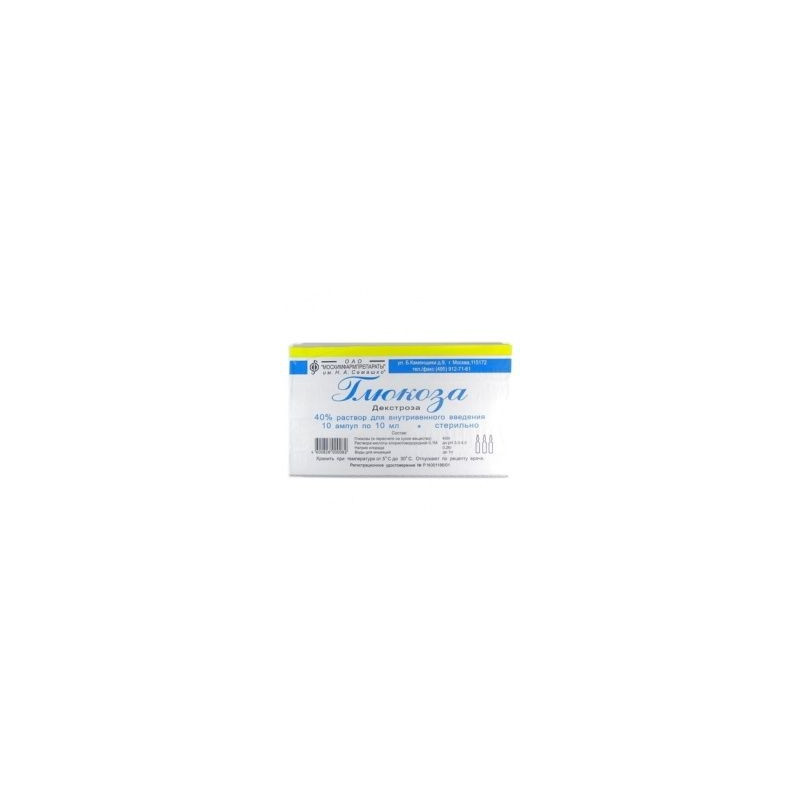



 All payments are encrypted via SSL
All payments are encrypted via SSL
 Full Refund if you haven't received your order
Full Refund if you haven't received your order
GLUCOSE AMP. 40% 10ML No. 10 *
Drug description
Glucose
Dextrose
intravenous solution, solution for infusions, tablets
Participates in various metabolic processes in the body, enhances the redox processes in the body, improves the antitoxic function of the liver. Infusion of dextrose solutions partially compensates for water deficiency. Dextrose, entering the tissue, is phosphorylated, turning into glucose-6-phosphate, which is actively involved in many parts of the body's metabolism. 5% dextrose solution has a detoxification, metabolic effect, is a source of valuable easily digestible nutrient. With the metabolism of dextrose in the tissues a significant amount of energy is released, which is necessary for the vital activity of the body. Hypertonic solutions (10%, 20%, 40%) increase the osmotic pressure of the blood, improve metabolism; increase myocardial contractility; improve the antitoxic function of the liver, dilate blood vessels, increase diuresis. The theoretical osmolarity of 10% dextrose is 555 mOsm / l, 20% - 1110 mOsm / l.
Hypoglycemia, insufficiency of carbohydrate nutrition, toxicoinfection, intoxication with liver diseases (hepatitis, degeneration and atrophy of the liver, incl.liver failure), hemorrhagic diathesis; dehydration (vomiting, diarrhea, the postoperative period); intoxication; collapse, shock. As a component of various blood-substituting and anti-shock liquids; for the preparation of solutions of drugs for the on / in the introduction.
Hypersensitivity, hyperglycemia, hyperlactacidemia, hyperhydration, postoperative disorders of glucose utilization; circulatory disorders threatening swelling of the brain and lungs; cerebral edema, pulmonary edema, acute left ventricular failure, hyperosmolar coma.C caution. Decompensated CHF, CRF (oligo-, anuria), hyponatremia, diabetes mellitus.
In / in the drip, 5% solution is injected with a maximum speed of up to 7 ml (150 cap) / min (400 ml / h); maximum daily intake for adults - 2 l. 10% solution - up to 60 drops / min (3 ml / min); maximum daily intake for adults - 1 l. 20% solution - up to 30-40 drops / min 1.5-2 ml / min; The maximum daily intake for adults is 500 ml. 40% solution - up to 30 drops / min (1.5 ml / min); The maximum daily intake for adults is 250 ml. In / in the jet - 10-50 ml of 5 and 10% solutions. In adults with normal metabolism, the daily dose of injected dextrose should not exceed 4-6 g / kg, i.e. about 250-450 g (with a decrease in the intensity of metabolism, the daily dose is reduced to 200-300 g), while the daily volume of injected liquid is 30-40 ml / kg. Along with fats and amino acids, 6 g of dextrose / kg / day is administered to children for parenteral nutrition, and up to 15 g / kg / day on the following day.When calculating the dose of dextrose with the introduction of 5 and 10% solutions of dextrose, the allowable amount of injected fluid must be taken into account: for children with a body weight of 2-10 kg - 100-165 ml / kg / day, children with a body weight of 10-40 kg - 45 -100 ml / kg / day. Injection rate: in the normal state of metabolism, the maximum rate of dextrose in adults is 0.25-0.5 g / kg / h (with a decrease in the intensity of metabolism, the introduction rate is reduced to 0.125-0.25 g / kg / h). In children, the rate of dextrose should not exceed 0.5 g / kg / h; which is for a 5% solution - about 10 ml / min or 200 drops / min (20 drops = 1 ml). For a more complete absorption of dextrose, administered in large doses, at the same time prescribed insulin at the rate of 1 U of insulin per 4-5 g of dextrose. Patients with diabetes dextrose administered under the control of its content in the blood and urine.
Hypervolemia, acute left ventricular failure. At the injection site - the development of infection, thrombophlebitis. Overdose. Symptoms: hyperglycemia, glycosuria, hyperglycemic hyperosmolar coma, overhydration, disruption of water and electrolyte balance. Treatment: stop the introduction of glucose, enter insulin, symptomatic therapy.
For a more complete and rapid absorption of dextrose, you can enter p / to 4-5 U of insulin, at the rate of 1 U of insulin for 4-5 g of dextrose.
When combined with other drugs, compatibility must be visually monitored (invisible pharmaceutical or pharmacodynamic incompatibility is possible).
